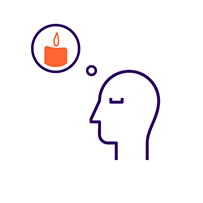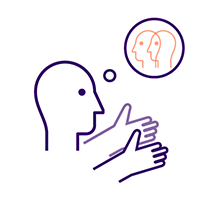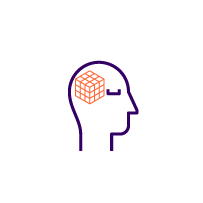Psychological treatment for anxiety disorders – the elements for individualising treatment
Anxiety disorders are common and disabling but there are many psychological treatments. Read more about these treatments for anxiety disorders, and the evidence supporting them.
Key points
- Psychological treatments, often including multiple treatment elements, are effective for treating anxiety disorders.
- Cognitive behavioural therapy (CBT) is the psychological treatment with the most evidence of efficacy. CBT has core treatment elements and may include other optional components.
- Some CBT and other psychological treatment elements have evidence of efficacy for specific anxiety disorders and may be included as part of a patient’s treatment strategy, based on appropriateness, availability and patient preference.
Download and print
Anxiety disorders
Anxiety disorders are the most common mental health conditions in Australia, affecting around 14% of people aged 16–85 years.1,2
Anxiety itself is a normal physiological response to a stressful situation. Often described as being nervous, worried or on edge,3 physiological symptoms of anxiety may include a pounding heart, shortness of breath, dizziness, trembling and the sensation of ‘butterflies in the stomach’.4
When this response is experienced frequently over a long period of time, is out of proportion to the stressor (or occurs even in the absence of an apparent stressor), and is affecting the patient’s daily life, it constitutes an anxiety disorder.4
Anxiety disorders have a range of different presentations.
- People with panic disorder (PD) experience sudden attacks of fear or anxiety, often with no obvious trigger, sometimes so severe that they think they may collapse or die.4
- People with social anxiety disorder (SAD) fear social settings and avoid situations where they may be subject to judgement or scrutiny by others.4
- Excessive worry over everyday things and being overly concerned about things that could go wrong are characteristics of generalised anxiety disorder (GAD).4
Diagnosis of specific anxiety disorders may be difficult and further complicated if the patient has comorbid depression and/or multiple anxiety disorders.4
Regardless of diagnosis, the first-line treatments of CBT or selective serotonin reuptake inhibitor (SSRI) are effective for multiple anxiety disorders and are recommended by the Royal Australian and New Zealand College of Psychiatrists (RANZCP) for PD, GAD and SAD.4 The choice of treatment approach should depend on patient preferences, presentation, accessibility and symptom severity.4
A range of psychological treatments are used for the treatment of anxiety disorders – some with more evidence of efficacy than others. In this article we look at some of the treatments prescribed, when they are used, and how effective they are. A lot of options are out there.
Cognitive behavioural therapy
Cognitive behavioural therapy is a broad term encompassing a variety of treatment elements, but most CBT programs have these key elements in common.4
- Arousal management: The goal is to reduce physical symptoms of anxiety through relaxation and exercise. This can include muscle tensing exercises – an approach called ‘applied relaxation’ – and breathing exercises.
- Graded exposure: The patient gradually faces the causes of their anxiety symptoms, learning to think differently about these situations through experience.
- Safety response inhibition: The patient restricts anxiety-reducing behaviours (such as escape or need for reassurance), thereby decreasing negative reinforcement, and breaking cycles of anxiety.
- Surrender of safety signals: The patient removes safety signals (such as the presence of a companion or mobile phone, or knowledge of the location of the nearest toilet), thereby learning how to adapt and cope in these situations.
- Cognitive strategies: The patient practices changing thinking patterns (called cognitive restructuring) targeting their exaggerated perception of danger.
Cognitive behavioural therapy is the most studied of all psychological treatments, with several meta-analyses demonstrating efficacy (compared with placebo) when treating anxiety disorders.5 A review of 87 studies of CBT for anxiety disorders in adults found 45.3% of patients with SAD, 53.2% of patients with PD and 47.0% of patients with GAD achieved stress reduction to normal levels.5,6
Computer-assisted and online CBT programs (eCBT) are also effective modalities for providing care and may be the preferred or most accessible treatment option.5 Clinical data suggest eCBT may be equally beneficial when compared to face-to-face CBT, with equivalent reductions in symptoms and disability and equivalent improvement in quality of life.4,7,8
The building blocks for CBT and other psychological treatments
Some of the key components of CBT can be used by themselves or as part of other psychological treatments for anxiety disorders. For example, applied relaxation, graded exposure and mindfulness are typically key elements of CBT that have also been studied separately as treatments for people with anxiety disorders. Other psychological treatments or treatment elements may not be core to CBT but can be part of a psychological treatment when appropriate.
What is the evidence, and when should some of these treatments be considered? Here are some of the psychological treatments and treatment elements that are used to treat anxiety disorders.
There is some evidence for the effectiveness of applied relaxation for GAD. Across three randomised controlled trials (RCTs) an effect size of 0.86 compared with waiting list was found.4,11
There is insufficient evidence for a conclusion on the effectiveness of applied relaxation alone compared with CBT for GAD, although initial evidence from four RCTs suggests CBT provides a significantly better outcome 12 months after treatment completion (OR 3.00, l2 0).4,11
The effect of applied relaxation for treating SAD appears to be smaller than for GAD, with an effect size of 0.51.4,12
Graded exposure
Graded exposure – where the patient is gradually exposed to feared situations – is another key component of CBT, and a psychological intervention that is also recommended to support pharmacological therapy.4 Through gradual and repeated exposure to the feared situation, the experience supports reduction in fear perceptions.4
A large body of evidence demonstrates the effectiveness of CBT (which includes an exposure element), and it is widely recommended in Australian and international guidelines.3,4,13 A meta-analysis found CBT without exposure was not very effective at reducing symptoms in panic disorder, compared with CBT that included exposure.14 For SAD it is less clear. One analysis found psychological treatments with exposure were slightly more effective than those without, although the difference was not statistically significant.15
Mindfulness

Mindfulness is often integrated with cognitive elements as part of CBT, called mindfulness-based cognitive therapy (MBCT).
Another common technique is mindfulness-based stress reduction (MBSR), which involves meditation, hatha yoga and a ‘body scan’ where focus is sequentially directed to different parts of the body.16,17
Meta-analyses show that mindfulness-based techniques are effective at reducing anxiety symptoms18 with MCBT appearing to be more effective than MBSR although the difference is not statistically significant.
Acceptance and commitment therapy
Acceptance and commitment therapy (ACT) focuses on two processes.19

- Accepting rather than fighting thoughts and emotions: In ACT the patient is taught to focus on the present and create a mental distance from thoughts and emotions. The patient does not judge or identify with the thoughts and emotions, but just observes them, and lets them exist.
- Committing and acting according to core values: The patient recognises their core values, uses these to identify self-damaging behaviours, and commits to and acts out new behaviours in line with these values.
Some of ACT involves mindfulness principles, focusing on experiences now – physical, mental and emotional – and accepting these without judgement.
Unlike CBT, ACT does not try to change negative thinking patterns, nor does it attempt to change the somatic response of the body to a trigger of anxiety (such as with applied relaxation).9
There is much interest in this psychological treatment but there is insufficient evidence of its effectiveness in treating anxiety disorders for it to be recommended as first-line treatment.4
Problem-solving therapy
Problem-solving therapy (PST) involves the patient learning or refreshing skills to solve specific life problems associated with psychological and physical symptoms. The role of the clinician is to empower patients to solve their own problems rather than to advise on possible solutions.20
The method involves finding a possible solution, implementing the solution and then assessing the outcome.20

The treatment is well suited to general practice and may be undertaken during 15–30 minute consultations.20,21
Although most research on PST has focused on depression, a small evidence base suggests that this intervention may also benefit patients with anxiety.4,20
Structured problem solving may be part of CBT treatments,4 and useful for patients who feel overwhelmed by multiple life difficulties, including relationship, financial or employment problems.20
Other psychotherapies
The range of psychotherapies for anxiety is vast, from art therapy to biofeedback to narrative therapy. The evidence for efficacy of these in the treatment of anxiety disorders varies widely. beyondblue has a good summary of options for treating anxiety, which includes levels of evidence and risks for each treatment.
See beyondblue’s 'A guide to what works for anxiety'
Considerations in psychotherapy for anxiety: Q&A with Alison Mahoney

Dr Alison Mahoney is a senior clinical psychologist at the Clinical Research Unit for Anxiety and Depression (CRUfAD) at St Vincent’s Hospital in Sydney. She has 15 years of experience working with people who have anxiety disorders.
How do you decide which management approach to use with an individual patient?
Choosing an evidence-based treatment is important and patient preference is paramount. If a patient isn’t interested in a particular treatment, it won’t work.
Find out what the patient has tried in the past and what they thought of that treatment. Ask which treatments they are interested in trying and which they object to. If the patient has no special preference, I’d recommend CBT.
Also, consider the severity of the patient’s illness. People who are severely depressed and anxious may have difficulty with cognitive exercises involving a lot of thinking, processing and verbal information. Consider starting with more behavioural strategies – getting them active and participating in exercise.
Financial constraints are very important to consider as is access to treatment.
Access becomes particularly important in regional or remote areas where face-to-face psychological treatments may not always be available. Internet-based treatments are an option for people with access to the internet. Telehealth options may also be available where psychologists offer remote treatments using patient workbooks (possibly online) and regular remote treatment sessions (using the phone). Some telehealth services can be rebated through Medicare.
The eMHprac website is a valuable site with information on the available e-mental health resources
What are transdiagnostic treatments and when do you recommend them?
Transdiagnostic treatments are effective across anxiety disorders and some other mental health conditions. Like always, the patient needs to be interested in engaging with the program and it needs to be an evidence-based program. These programs not only treat the primary disorder, but also treat the comorbid disorders.
There is even some evidence that they are better at treating the comorbid disorders than diagnostic-specific programs. So, if the patient had a number of anxiety disorders, with or without a depressive disorder as well, a transdiagnostic program could be suitable.
If I was a GP with only 15 minutes to see the patient, I may struggle to diagnose a specific anxiety disorder, but I would probably be able to see if the patient was experiencing clinically significant anxiety. I would feel comfortable referring them to a transdiagnostic treatment as the specific disorder is less important. It doesn’t really matter if they have social phobia or GAD or PD; the processes underlying an effective CBT intervention are the same across all the anxiety disorders.
What are the essential elements that should be included in a mental health care plan?
A preliminary diagnosis is helpful. Is there an anxiety disorder? Is there secondary depression? Is there self-harm? Is the patient showing suicidal, homicidal or psychotic behaviours? A treatment history if possible, and some psychosocial history is useful as well. Is the patient working? Have they got family around?
Some GPs may have a preferred outcome assessment tool – for example the K10. The psychologist can administer this after the sessions with the patient and the GP can get a sense of whether the patient is moving forward.
Have you got tips for a GP who would like to deliver relaxation, problem-solving, graded exposure and mindfulness techniques?
It is always important to explain the rationale behind a treatment – why should the patient consider doing this treatment and how does it work?
Look at concrete ways of implementing the treatment and how to customise it to the patient’s needs. For example, with relaxation, the patient could download audio, buy a relaxation CD or download an app. Does the patient prefer a male or female voice?
Explore the barriers the patient may have in following the treatment.
- Do they have any fears about the treatment?
- Are their expectations realistic? For instance, do they think psychological treatments or meditation exercises will turn them into a hippy or change their personality in some way?
- Do they fear a medication will be addictive or make them psychotic?
If patients don’t hold realistic ideas about treatment, ask them to tell you more. Perhaps, they know someone who has had a bad experience. Talking to the patient and problem-solving the barriers is key.
Problem-solving therapy can help if the person has a problem for which they are responsible, and which can be addressed by changing behaviour. A problem with debt is the patient’s responsibility and can have a practical solution. Being worried about getting dementia decades into the future may be the patient’s responsibility but is not addressable directly in the present.
Learning how and when to act on problems is valuable. Knowing a problem is not the patient’s responsibility or there is nothing they can do about it can help with letting go.
For graded exposure, I would expect most GPs to refer the patient to a specialist – not because they can’t do it, but because they may not have enough time in the consultation. When you ask a patient to do something intimidating and frightening, it needs to be done within a trusting and safe relationship. Many GPs establish that with their patients, but you need to give the patient the time to desensitise and habituate, and this doesn’t usually happen in 15 minutes.
If the GP would like to manage the graded exposure themselves, I would recommend using external resources to support the process. There are excellent online resources (online programs and workbooks) that go through the principles of overcoming fears. These are usually embedded in a CBT package.
For all treatments, the GP plays an important role in holding the patient accountable. Regularly ask how the patient is coming along with the treatment.
For example, someone with arachnophobia, you may ask ‘Last week you were going to look at pictures of cartoon spiders. How did you go with that?’ If you never ask, the patient is more likely to stop doing it.
Is there anything else you would like to say to GPs treating patients with anxiety?
GPs really do a great job. They are the gateway, helping people to realise and say that they are struggling with anxiety, and helping them to have the courage to consider treatment and seek a specialist.
I think hope is a really important thing. Anxiety disorders are chronic, and not everything will work for everybody. Specialists may come in and come out of a journey, but if the GP can be there for the patient in an ongoing way, it is so important.
You can’t underestimate the power of being hopeful and consistently being willing to help and saying, ‘let’s do it together!’.
References
- Australian Bureau of Statistics. National Survey of Mental Health and Wellbeing: Summary of Results. 2007 (accessed 14 September 2018).
- Harris MG, Hobbs MJ, Burgess PM, et al. Frequency and quality of mental health treatment for affective and anxiety disorders among Australian adults. Med J Aust 2015;202:185-9.
- Katzman MA, Bleau P, Blier P, et al. Canadian clinical practice guidelines for the management of anxiety, posttraumatic stress and obsessive-compulsive disorders. BMC Psychiatry 2014;14 Suppl 1:S1.
- Andrews G, Bell C, Boyce P, et al. Royal Australian and New Zealand College of Psychiatrists clinical practice guidelines for the treatment of panic disorder, social anxiety disorder, and generalised anxiety disorder. ANZJP 2018;52:1109-72.
- Craske MG, Stein MB. Anxiety. Lancet 2016;388:3048-59.
- Loerinc AG, Meuret AE, Twohig MP, et al. Response rates for CBT for anxiety disorders: Need for standardized criteria. Clin Psychol Rev 2015;42:72-82.
- Andrews G, Basu A, Cuijpers P, et al. Computer therapy for the anxiety and depression disorders is effective, acceptable and practical health care: An updated meta-analysis. J Anxiety Disord 2018;55:70-8.
- Olthuis JV, Watt MC, Bailey K, et al. Therapist-supported Internet cognitive behavioural therapy for anxiety disorders in adults. Cochrane Database Syst Rev 2016;3:CD011565.
- Craske MG. Psychotherapy for generalized anxiety disorder in adults. UptoDate Waltham, MA, USA: Wolters Kluwer, 2018 (accessed 10 May 2018).
- Ost LG. Applied relaxation: description of a coping technique and review of controlled studies. Behav Res Ther 1987;25:397-409.
- Cuijpers P, Sijbrandij M, Koole S, et al. Psychological treatment of generalized anxiety disorder: a meta-analysis. Clin Psychol Rev 2014;34:130-40.
- Fedoroff IC, Taylor S. Psychological and pharmacological treatments of social phobia: a meta-analysis. J Clin Psychopharmacol 2001;21:311-24.
- National Institute for Health and Care Excellence. Common mental health problems: identification and pathways to care: NICE Clinical guideline 123. UK: NICE, 2011 (accessed 8 March 2018).
- Sanchez-Meca J, Rosa-Alcazar AI, Marin-Martinez F, et al. Psychological treatment of panic disorder with or without agoraphobia: a meta-analysis. Clin Psychol Rev 2010;30:37-50.
- Acarturk C, Cuijpers P, van Straten A, et al. Psychological treatment of social anxiety disorder: a meta-analysis. Psychol Med 2009;39:241-54.
- Hofmann SG, Sawyer AT, Witt AA, et al. The effect of mindfulness-based therapy on anxiety and depression: A meta-analytic review. J Consult Clin Psychol 2010;78:169-83.
- Baer R. Mindfulness training as a clinical intervention: a conceptual and empirical review. Clin Psychol Sci Prac 2003;10:125-43.
- Khoury B, Lecomte T, Fortin G, et al. Mindfulness-based therapy: a comprehensive meta-analysis. Clin Psychol Rev 2013;33:763-71.
- Harris R. Embracing your demons - an overview of acceptance and commitment therapy. Psychotherapy in Australia 2006;12 (accessed 12 September 2018).
- Pierce D. Problem solving therapy - use and effectiveness in general practice. Aust Fam Physician 2012;41:676-9.
- Hickie IB. An approach to managing depression in general practice. Med J Aust 2000;173:106-10.
